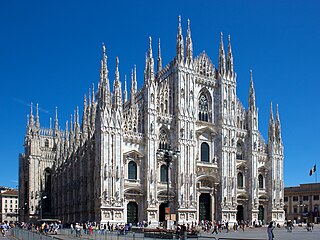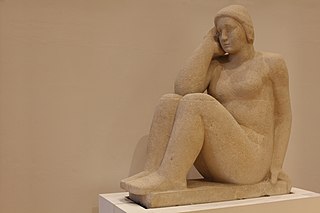Related Research Articles

The Triennale di Milano is a museum of art and design in the Parco Sempione in Milan, in Lombardy in northern Italy. It is housed in the Palazzo dell'Arte, which was designed by Giovanni Muzio and built between 1931 and 1933; construction was financed by Antonio Bernocchi and his brothers Andrea and Michele.

The Italian city of Milan is one of the international tourism destinations, appearing among the forty most visited cities in the world, ranking second in Italy after Rome, fifth in Europe and sixteenth in the world. One source has 56% of international visitors to Milan are from Europe, 44% of the city's tourists are Italian, and 56% are from abroad. The most important European Union markets are the United Kingdom (16%), Germany (9%) and France (6%). Most of the visitors who come from the United States to the city go on business matters, while Chinese and Japanese tourists mainly take up the leisure segment.
In 2000 Paolo Brescia and Tommaso Principi established the collective OBR to investigate new ways of contemporary living, creating a design network among Milan, London and New York. After working with Renzo Piano, Paolo and Tommaso have oriented the research of OBR towards the integration artifice-nature, to create sensitive architecture in perpetual change, stimulating the interaction between man and environment. The team of OBR develops its design activity through public-private social programs, promoting – through architecture – the sense of community and the individual identities. Today OBR is group open to different multidisciplinary contributors, cooperating with different universities, such as Accademia di Architettura di Mendrisio, Aalto University, Academy of Architecture of Mumbai and Mimar Sinan Fine Art University. Among the best known works by OBR are the Pythagoras Museum, the New Galleria Sabauda in Turin, the Milanofiori Residential Complex, the Children Hospital in Parma, the Galliera Hospital in Genoa, the Lido of Genoa, the Ex Cinema Roma, the Triennale di Milano Terrace. The under construction projects by OBR include the Lehariya Cluster in Jaipur, the Jafza Traders Market in Dubai and the Multiuse Complex Ahmad Qasir in Teheran. OBR's projects have been featured in Venice Biennale of Architecture, Royal Institute of British Architects in London, Bienal de Arquitetura of Brasilia, MAXXI in Rome and Triennale di Milano. OBR has been awarded with the AR Award for Emerging Architecture at RIBA, the Plusform under 40, the Urbanpromo at the 11° Biennale di Venezia, the honourable mention for the Medaglia d'Oro all'Architettura Italiana, the Europe 40 Under 40 in Madrid, the Leaf Award overall winner in London, the WAN Residential Award, the Building Healthcare Award, the Inarch Award for Italian Architecture and the American Architecture Prize in New York. Since 2004 OBR has been evolving its design parameters according to the environmental and energy certification LEED and since 2009 OBR is partner of the GBC.
The Milan Triennial is an art and design exhibition that takes place every three years at the Triennale di Milano Museum in Milan, Italy.
Antonello Silverini is an Italian illustrator. He is the first illustrator awarded the MAM prize. He has collaborated with Il Sole 24 Ore, La Repubblica, Panorama, l'Espresso, The Boston Globe, The Economist, and The Washington Post and has designed book covers for several novels, including those of Ian McEwan for Einaudi [2] and Philip K. Dick for Fanucci.

The Milan Triennial VI was the Triennial in Milan sanctioned by the Bureau of International Expositions (BIE). Its theme was Continuity – Modernity. It was held at the Palazzo dell'Arte with some exhibits on the Parco Sempione and ran from 31 May 1936 - 1 November 1936.

The Milan Triennial V was the first to be held at the Palazzo dell'Arte, the first recognised by the Bureau of International Expositions and also the first to be a triennial event.

The Milan Triennial VII was the triennial in Milan sanctioned by the Bureau of International Expositions (BIE) on the 9 November 1938. Its theme was Order - Tradition. It was held at the Palazzo dell'Arte and ran from 6 April 1940 to 9 June 1940, when Italy entered the Second World War.
The Milan Triennial IX was the Triennial in Milan sanctioned by the Bureau of International Expositions (BIE) on the 7 June 1950. Its theme was Goods - Standard. It was held at the Palazzo dell'Arte and ran from 12 May 1951 to 5 November 1951.

The Milan Triennial X was the Triennial in Milan sanctioned by the Bureau of International Expositions (BIE) on the 5 November 1953. Its theme was Prefabrication - Industrial Design. It was held at the Palazzo dell'Arte and ran from 28 August 1954 to 22 November 1954.

The Milan Triennial XII was the Triennial in Milan sanctioned by the Bureau of International Expositions (BIE) on the 5 May 1959. Its theme was House and School. It was held at the Palazzo dell'Arte and ran from 16 July 1960 to 4 November 1960.
The Milan Triennial XIV was the Triennial in Milan sanctioned by the Bureau of International Expositions (BIE) on the 11 May 1966. Its theme was The Large Number. It was held at the Palazzo dell'Arte and ran from 23 June 1968 to 28 July 1968.
The Milan Triennial XVII was the Triennial in Milan sanctioned by the Bureau of International Expositions (BIE) on the 5 June 1986. Its theme was The Cities of the World and the Future of the Metropolis. It was held at the Palazzo dell'Arte and ran from 21 September 1988 to 18 December 1988.

The Milan Triennial VIII was the Triennial in Milan sanctioned by the Bureau of International Expositions (BIE) on the 11 June 1946. Its theme was The House. It was held at the Palazzo dell'Arte and ran from 31 May 1947 to 14 September 1947.
The Milan Triennial XIX was the Triennial in Milan sanctioned by the Bureau of International Expositions (BIE) on the 8 June 1994. Its theme was Identities and Differences. It was held at the Palazzo dell'Arte and ran from 22 February 1996 to 5 May 1996.
The Milan Biennial III was the third edition of the Monza Biennial. This, and the other 3 biennials, were organised by the Istituto Superiore per le Industrie Artistiche (ISIA) to provide an arts vision for the new Kingdom of Italy. It was called the International Exhibition of Decorative Arts.
The Milan Biennial III was the third edition of the Monza Biennial, and the last to focus on ceramics, graphic and the decorative arts, before expanding scope to include architecture. This, and the other 3 biennials, were organised by the Istituto Superiore per le Industrie Artistiche (ISIA) to provide an arts vision for the new Kingdom of Italy. It was called the International Exhibition of Decorative Arts.
The Milan Biennial IV was the fourth biennial, and like the earlier ones was organised by the Istituto Superiore per le Industrie Artistiche (ISIA) and held in Monza at the Royal Villa of Monza. It was called the International Exhibition of Modern Decorative and Industrial Arts, a change in name from the earlier three, and had an increased scope including architecture. It and ran from 11 May to 2 November 1930.

Eugenio Gerli was an Italian architect and designer. In an intense working life spanning more than six decades, Eugenio Gerli explored many different areas of his profession. He built villas, apartment blocks, office blocks, factories, banks and stores, and also restored historic buildings. He often completed his works with custom-made interiors and furniture.This diverse range of projects inspired his industrial design and today many have become icons, like the S83 chair, the PS 142 armchair Clamis, the Jamaica cabinet and the Graphis System.

Alessandro Mazzucotelli was an Italian craftsman, particularly known as a master ironworker and decorator. A specialist in wrought iron, Mazzucotelli linked his fame to the decorations of the works of the major exponents of Art Nouveau in Italy and abroad.
References
- 1 2 3 4 5 "The international Exhibitions of the Triennale di Milano" . Retrieved 17 December 2018.
- 1 2 "Guido Marangoni and the Biennials of Monza, 1923-1927, Design before Design, Villa Reale di Monza - ARTDIRECTORY" . Retrieved 17 December 2018.
- ↑ "La Triennale di Milano » History and Mission" . Retrieved 17 December 2018.